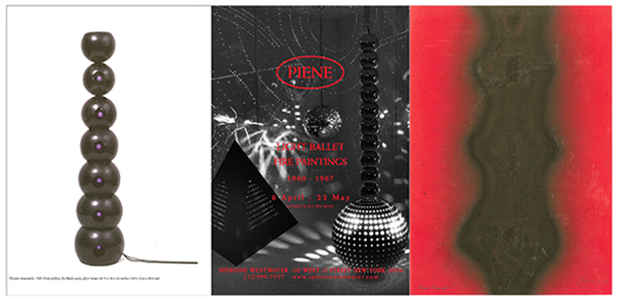Otto Piene "Light Ballet and Fire Paintings, 1960-1967"
Sperone Westwater

This event has ended.
Sperone Westwater presents a solo exhibition of Otto Piene’s historical Light Ballet sculptures and Fire Paintings from 1960 to 1967. Piene created these works during the prime years of the ZERO movement, which he founded with artist Heinz Mack (and later Günther Uecker) in Düsseldorf in 1957. Reacting to the personally charged post-war expressionism in Germany, the ZERO group banished psychological expression in their work and often used nontraditional art materials. A leading figure in kinetic and technology-based art, Piene employs the use of light and the surrounding environment in his Light Ballet and Fire Paintings, and demonstrates the connection between art, nature, and science.
The idea of Light Ballet originated in 1959 after Piene directed lights through the stencils of his earlier “raster” (grid) paintings, forming moving projections in the room. Piene’s kinetic light ballets are on view, including earlier types with construction work lights. The sculpture Light Ballet on Wheels (1965) consists of a black aluminum drum with a revolving disk and two lamps, which projects light in varying forms onto the ceiling and walls. Electric Anaconda (1965) is a five-foot column of seven flat black painted brass globes with argon bulbs that light up in timed phases. The intent is to expand the viewer’s perception of the space and encourage participation in the play of light. Piene describes these performative sculptures:
The term Light Ballet can be taken literally: as a light “dance” in a specific order and “choreographic” sequence, more or less improvised according to the sound, which is inserted as a guiding beam […] I attempt to give the Light Ballet the naturalness that breathing in and out has for the man who is alive. A nuanced flow of light interests me more than a clash of contrasts. The sound is not music but an accompanying, and at times leading, noise, which among other things has the task of creating a chosen silence, in which the light is then alone.
Piene’s study of light continues in his smoke and fire paintings. Using smoke (soot), Piene often creates a hazy gray and black target-like form against a light background, as in Rauchbild (1961). In the Fire Paintings, Piene lightly burns a layer of solvent on pigmented paper, developing organic forms from the remnant, or the soot. According to the artist in 1965, “pictures grew within seconds on a border line between destruction and survival – the “Fire Flowers.” Works, such as Heat Flower (1967) and Red Sky (1967), are part of the Fauna and Flora series, which explicitly reference nature.
Piene was born in Laasphe, Westphalia, Germany in 1928, and he lives and works in Düsseldorf, Cambridge, and Groton, Massachusetts. From 1948 to 1953 he attended the Blocherer Art School and studied painting at the Academy of Art in Munich and the Staatliche Kunstakademie in Düsseldorf. Piene graduated with a philosophy degree from the University of Cologne in 1957—the year ZERO was founded. After serving as a Visiting Professor at the University of Pennsylvania in 1964, Piene became the first Fellow of the MIT Center for Advanced Visual Studies (CAVS) from 1968 to 1971, during which he coined the term “Sky Art” for large outdoor sky/light projects, such as Olympic Rainbow for the 1972 Munich Olympics. In the same year, Piene became Professor of Environmental Art at MIT. From 1974 to 1994, he was director of the CAVS. Piene’s solo exhibitions include retrospectives at the Kunstmuseum im Ehrenhof (Düsseldorf, Germany, 1996) and at the Prague City Gallery (Prague, Czech Republic, 2002), and a show at the Museum am Ostwall (Dortmund, 2008-2009). In 2008, Piene presented a Sky Event during Nuit Blanche in Paris.
Media
Schedule
from April 06, 2010 to May 22, 2010
Opening Reception on 2010-04-06 from 18:00 to 20:00